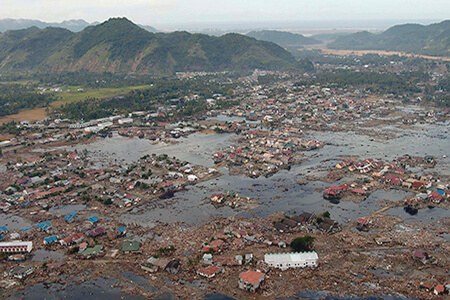This is a lesson summary. The full lesson can be viewed by purchasing an online course subscription.
Learning Objective
In this lesson we will learn what earthquakes and tsunamis are and discuss how and where they occur.
Learning Outcomes
By the end of this lesson you will be able to:
- Describe what earthquakes are and explain how they occur.
- Compare the different types of faults and the types of plate boundaries they are associated with.
- Compare the different types of seismic waves.
- Describe how earthquakes are detected and measured, and compare the Richter scale and Mercalli scale.
- Describe what tsunamis are and explain how they occur.

(Image: Philip A. McDaniel, Wikimedia Commons)
Lesson Summary
- An earthquake is a sudden release of energy, in the form of seismic waves, caused by movement within Earth’s crust.
- Earthquakes involve movement along faults, which are fractures or boundaries between two bodies of rock.
- The point within Earth’s crust where an Earthquake originates is called the focus or hypocentre.
- The point on Earth’s surface that is directly above the focus is called the epicentre.
- Most earthquakes occur at tectonic plate boundaries – these are referred to as interplate earthquakes.
- Earthquakes that occur away from plate boundaries are known as intraplate earthquakes.
- The strongest earthquakes are usually associated with convergent and transform plate boundaries.
- Earthquakes involve slips along existing faults or the formation of new faults.
- The three main types of faults are:
- Normal faults – faults involving downward movement along an inclined plane.
- These are mostly associated with divergent plate boundaries.
- Reverse faults (thrust faults) – faults involving upward movement along an inclined plane.
- These are mostly associated with convergent plate boundaries.
- Strike-slip faults (lateral faults) – faults involving sideways movement along a vertical plane.
- These are mostly associated with transform plate boundaries.
- Normal faults and reverse faults are collectively referred to as dip-slip faults.
- The energy released by an earthquake is transferred as seismic waves.
- The three main types of seismic waves are:
- P-waves ( Primary waves) – waves that oscillate back and forth, in line with the direction of energy transfer.
- P-waves have the highest speed and the smallest amplitude.
- S-waves (Secondary waves) – waves that oscillate up and down, perpendicular to the direction of energy transfer.
- Surface waves – waves that are confined to the region near Earth’s surface; they include Love waves, which oscillate from side to side, perpendicular the transfer of energy, and Rayleigh waves, which oscillate in an elliptical direction.
- Surface waves have the lowest speed and the largest amplitude.
- P-waves and S-waves are known as body waves as they travel through Earth’s interior.
- Earthquakes are detected using a seismometer (seismograph), which produces a graphical representation of an earthquake known as a seismogram.
- Since seismic waves travel at different speeds, the differences in their arrival times can be used to determine how far away an earthquake occurred.
- By using three or more seismometers in different locations, the location of an earthquake’s epicentre can be determined.
- The two main ways of measuring earthquakes are the Richter scale and the Mercalli scale.
- The Richter scale is a measure of the amount of energy released – in other words, the earthquake’s magnitude.
- It is a logarithmic scale from 1 to 10.
- The Mercalli scale is a measure of the amount of damage done – in other words, the earthquake’s intensity.
- It is a descriptive scale from I-XII.
- Earthquakes that occur under water can trigger enormous, destructive waves known as tsunamis.
- Most tsunamis are associated with subduction zones, where the overlying tectonic plate becomes elastically squeezed before rebounding.

(Image: Negro Elkha, Adobe Stock)
(Header image: H.D. Chadwick, Wikimedia Commons)
